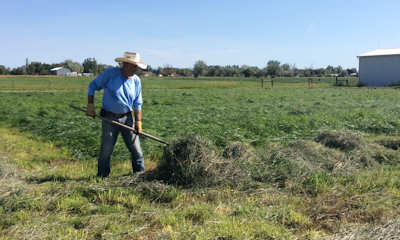October 1, 2015

Gerry Danko of Powell, Wyo., and other farmers know that the devil is in the details when it comes to cutting and baling premium hay.
“Hay should be cut before plants are overly mature. As grasses start to head out, nutrient levels drop. The plant is interested in only producing its seed so you want to cut before it’s headed out,” Danko says.
And when it comes to cutting, there is an optimum period between mid-morning and very early afternoon when nutrients are still in the stalks, but warming temperatures combined with even a slight breeze evaporate dew on the plants.

GETTING THE TIMING RIGHT. Gerry Danko spends quality time with his hay crop to make sure he's putting it up at its peak.
“The highest quality hay will be what you cut between about 9 or 10 a.m. and noon or 1 p.m. During this period, protein levels rise about a point or two,” he says. “As the plant is stressed later in the afternoon with wind and sun, nutrients are drawn back down.”
Danko, though, clearly knows the difference between idealism and realism.
“Mother Nature doesn’t give you a lot of options sometimes. There’s a place when you want to cut and a place when you have to cut, and that might not be the same day.”
If at all possible, Danko avoids turning the hay after cutting because that’s when you lose the bright green color.
“Nutrients drop as the sun bleaches the hay,” he says.
Grass vs. alfalfa
Come baling time, Danko says, “If grass hay has a little more moisture than I want, I’ll stand it up with spider wheels to let the air run through it, but I won’t turn it all the way. I’ll bale that afternoon because you want to make sure most of the moisture is out. It should smell like really nice grass, not fresh-mowed grass off your lawn.”

Gerry Danko, Powell, Wyo.
Danko uses a moisture tester on the baler and also carries a portable probe, stopping every 20 minutes to monitor moisture.
“I try to stay under 15% moisture for grass hay for horses,” he says. “You don’t want any molds or dust to form.”
For alfalfa, he’ll wait for plants to become totally dry the afternoon before baling, and then bale early the next morning when the moisture content is around 16–20%. This is typically from 2–5:30 a.m.
“You want to bale alfalfa when there is toughness to the hay. When you crush it in your hands, the hay shouldn’t shatter,” he says. “Shortly after sunrise, the heavier dew comes in, and that will shut you down. Then you have to wait for that 16–20 moisture range again, which is usually from 8 a.m. to 1 p.m. under ideal conditions.”
When handling mixed grass/alfalfa hay (50% grass or more), handle it like grass, he says.
“Bale it dry because you are probably baling for the horse market so no mold, dust or unhappy horses will result. The grass will cushion the alfalfa and capture the leaves that are somewhat shattered. You will have really pretty hay, especially if it hasn’t been rained on or turned more than once.”
You May Also Like




